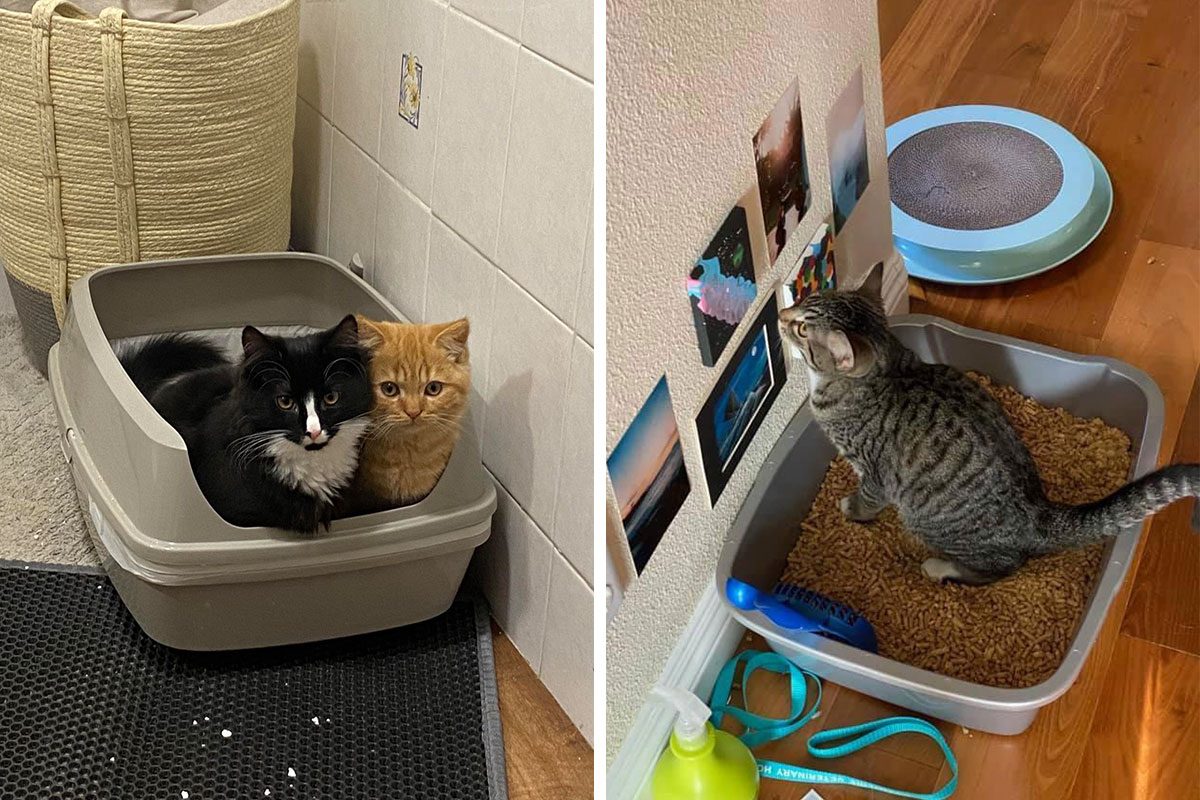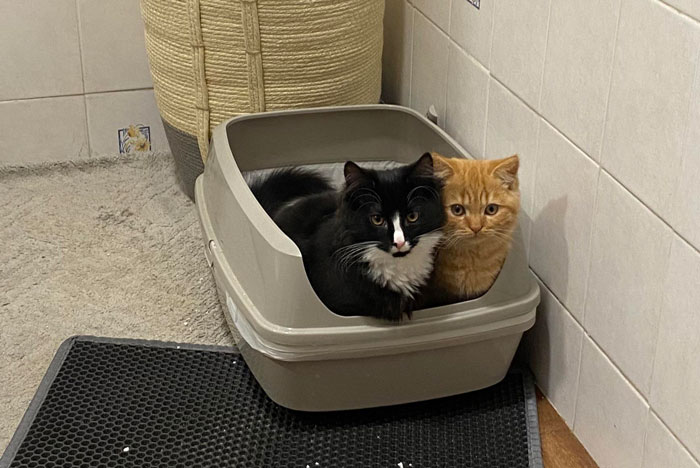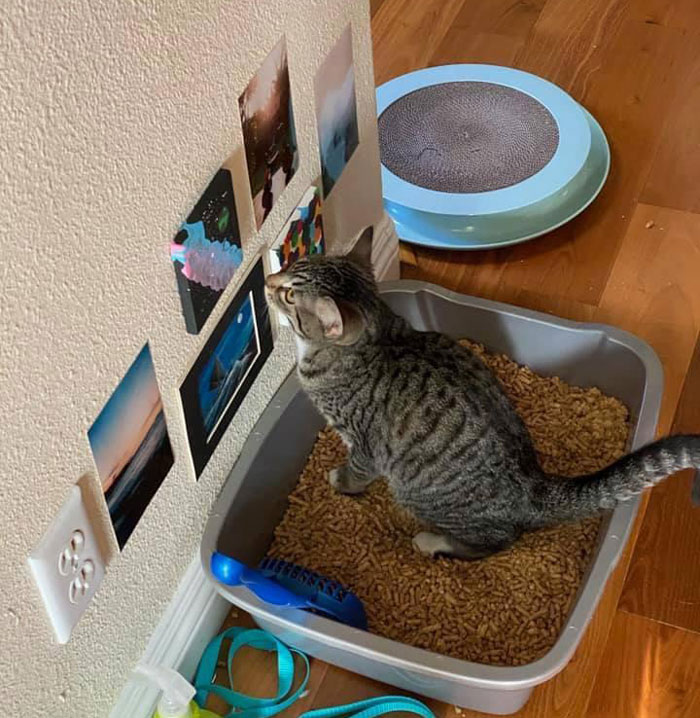For our clever felines, it is an instinctive behavior to use their litter tray, making life a lot simpler for us. Cats are hardwired to pass urine and stool in soil, dirt, or sand, so when we mimic this sort of substrate with a litter tray, it will be a natural impulse to use the tray.
In the wild, a cat may bury its excrement to keep any predators away, hiding its scent. They also bury their cat poop as a means of keeping their environment clean and reducing smell. They have a natural instinct to be hygienic, which they learn from their mother from a very young age.
- Cats instinctively use litter trays mimicking soil or sand.
- Kittens typically learn litter box use at just a few weeks old.
- Adult strays may require time & encouragement for litter training.
- Cats often know to use a litter box by sensing suitable substrate.
- Vet intervention needed if cats suddenly avoid the litter box.
The information provided herein is for informational purposes only. Please refer to our disclaimer for more details..
- How do cats learn to pee in a litter box?
- Do kittens naturally know how to use a litter box?
- Will a stray cat know how to use the litter box?
- Can cats sense where their litter box is?
- Should I see the vet if my pet is not using their litter tray after several days?
- What are the best tips for litter training?
How do cats learn to pee in a litter box?
Luckily for cat owners, these clever creatures have been designed by nature to use the toilet without us even having to teach them what to do. Domestic cats seek out cat litter and know how to use a litter tray from a young age.
Some cats will need litter box training if they use other areas to pass urine (like piles of clothes or beds), but this would be the exception rather than the rule.
Some kittens may need a bit of a nudge in the right direction, which usually means focusing on their environment. As they instinctively want to dig and cover their excrement, if we leave out piles of clothes, this can cause confusion. When young, ensure their litter box is the most attractive toilet on offer.
Do kittens naturally know how to use a litter box?
Yes, most kitties quickly learn how to use their litter box without us having to do anything much. They want to bury their waste and don’t enjoy toileting outside the box. Most know to use a litter tray from 4 weeks of age if we provide a clean and easily accessible tray.
However, some cats take a little longer than others to learn. You can help by placing your cat in the tray when they are posturing to the toilet and rewarding them with praise and perhaps a tasty treat when they are successful.
Will a stray cat know how to use the litter box?
If an adult cat is brought into a home and has never toileted inside before, it may take them a little longer to get the hang of things. They often require gentle encouragement in the form of treats and praise.
We should ensure there are always 2 clean boxes available in areas of the home with low foot traffic. For owners with another cat, there should be even more trays a cat can’t be expected to share.
It can help to place the cat in the tray about 10-20 minutes after a meal and to stir the litter around using a spoon or stick. For some, this encourages them to dig and then go to the toilet.
Can cats sense where their litter box is?
Yes, cats have an instinct to bury their feces and cover their urine, so if the litter box contains a substrate that can do this (like sand, shredded paper, or beads), they will know what the litter box is designed for.
When you use a covered box, it may take a little longer for the cat to learn, but you can help them out by placing them inside and showing them the potty.
If you have bought a new litter tray, you can place some of the old, used litter in it, so there is no dispute about the purpose of the new toilet in the home! The odor will attract them there.
Should I see the vet if my pet is not using their litter tray after several days?
We generally don’t need the help of a veterinarian when it comes to toilet training. Even if it has been a few days without success, most kittens will soon cotton on as long as we are consistent with our training and offering 2 clean litter trays.
However, it is a different story if a cat seems to stop using the litter box, though they could have done so before.
Causes for this can include stress, cystitis, a urinary tract infection, constipation, or kidney disease.
If you find puddles around the home or your cat avoids using the litter box, they must visit their vet for a check-up.
What are the best tips for litter training?
Thankfully, cats are clean creatures, and it is much easier to train them than a puppy! They generally choose to defecate and urinate in the trays provided, so as long as we have two clean trays per kitty in easy-to-reach places, they should be used quickly.
Remember, never punish your kitten if they have an accident outside of the tray, as this can lead to anxiety. Instead, quickly scoop them up and gently place them in their tray if they are trying to toilet outside of it. Soon, it will become a habit for your furry friend.
475views
Share on FacebookWhen we brought home our cat from the shelter, the first thing my husband asked me was how we were going to litter train her. It was his first inside cat. I said, "Watch me." I picked her up, took her to the litter box and plopped her down. I told my husband, "She's trained." He was shocked. I know it can be harder with older, feral cats, but she was pretty young when we got her so it wasn't an issue.
My cat was feral. She is 15 mos. old. She got used to a Booda Dome but wouldn't use it, alas, in the bathroom so it's in the living room now (only other place it can go). She is using it to poop but urinating regularly on my white sculpted living room rug. She is still pretty skittish so I have not made an issue of this, but it's really upsetting. She is also hiding under the bed almost the whole day. Very friendly and affectionate when she comes out to the kitchen for food. Even let's me comb and brush her at times. What am I doing wrong?
Linda, have you taken her to the vet to be sure she doesn't have a urinary tract infection? Most cats want to go in their box. When they go outside of it, it's often a sign of a UTI. And they're pretty common in cats. When mine goes outside her box, I know to take her to the vet immediately because it's almost always a UTI. If you don't have one already, you might invest in a pet fountain too. Cats prefer drinking the moving water and it helps prevent the UTIs. Also, feral cats are really skittish in general. It may take her some time to stop hiding. My cat was a rescue. She was 4 months old. Evidently she was starving on the street, so even now, 8 years later, she'll still incredibly food insecure. And still very jumpy. You just have to be patient with them.
Load More Replies...When we brought home our cat from the shelter, the first thing my husband asked me was how we were going to litter train her. It was his first inside cat. I said, "Watch me." I picked her up, took her to the litter box and plopped her down. I told my husband, "She's trained." He was shocked. I know it can be harder with older, feral cats, but she was pretty young when we got her so it wasn't an issue.
My cat was feral. She is 15 mos. old. She got used to a Booda Dome but wouldn't use it, alas, in the bathroom so it's in the living room now (only other place it can go). She is using it to poop but urinating regularly on my white sculpted living room rug. She is still pretty skittish so I have not made an issue of this, but it's really upsetting. She is also hiding under the bed almost the whole day. Very friendly and affectionate when she comes out to the kitchen for food. Even let's me comb and brush her at times. What am I doing wrong?
Linda, have you taken her to the vet to be sure she doesn't have a urinary tract infection? Most cats want to go in their box. When they go outside of it, it's often a sign of a UTI. And they're pretty common in cats. When mine goes outside her box, I know to take her to the vet immediately because it's almost always a UTI. If you don't have one already, you might invest in a pet fountain too. Cats prefer drinking the moving water and it helps prevent the UTIs. Also, feral cats are really skittish in general. It may take her some time to stop hiding. My cat was a rescue. She was 4 months old. Evidently she was starving on the street, so even now, 8 years later, she'll still incredibly food insecure. And still very jumpy. You just have to be patient with them.
Load More Replies...
 Image credits:
Image credits:  Image credits:
Image credits: 


11
3